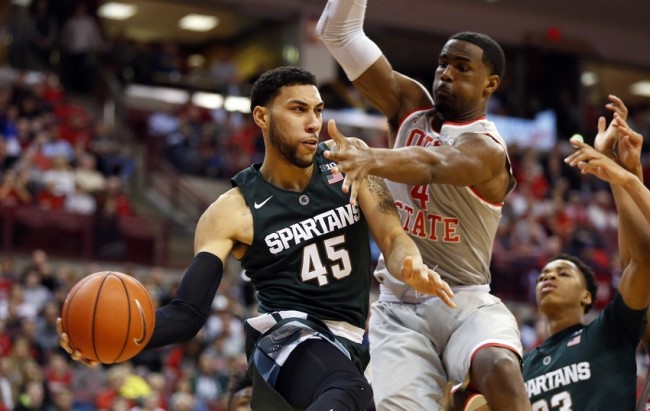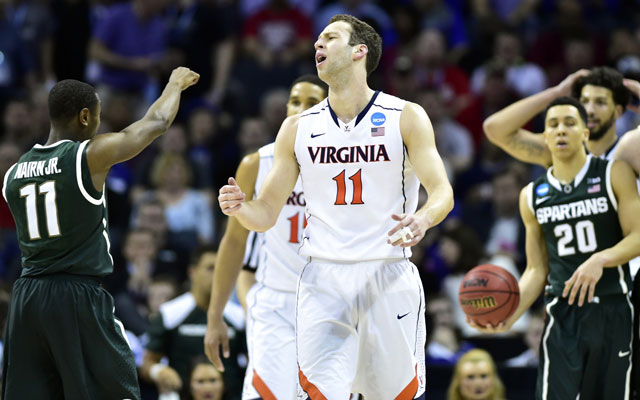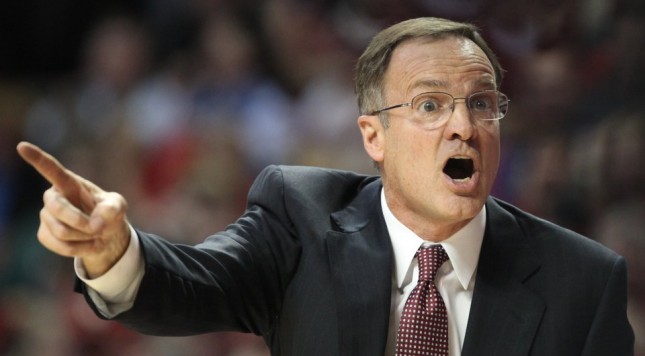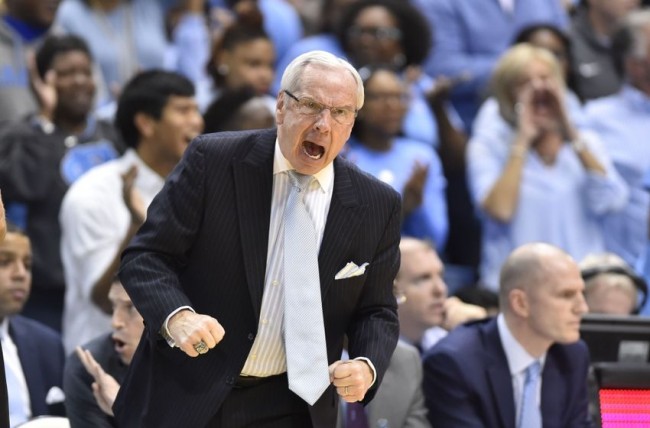Human beings can always use a timely reminder about anything from relationships to job applications to family obligations, anything under the sun.
This includes the NCAA tournament.
The bubble race is its own separate drama — plenty has been written about that, and plenty will continue to be in the lead-up to Selection Sunday. However, the other main source of intrigue during this specific week is the battle for No. 1 seeds. Ostensibly, the top seed in a region is supposed to bring with it the easiest draw on The Road To The Final Four.
This is a natural point of interest; seeding can open doors to college basketball’s final weekend under a big dome in early April.
The reminder: 1 seeds might mean a lot, but they’re not everything.

Feb 23, 2016; Columbus, OH, USA; Michigan State Spartans guard Denzel Valentine (45) speeds past Ohio State Buckeyes center Daniel Giddens (4) during the second half at Value City Arena. The Spartans won 81-62. Mandatory Credit: Joe Maiorana-USA TODAY Sports
There is widespread acknowledgment that Kansas has the No. 1 seed in the Midwest Region locked up. Chicago is the site of the regional. It is uniformly felt that Villanova has the 1 seed in the East secured. That’s perhaps the most valuable No. 1 seed on the board, in that it will give the Wildcats the ability to play the regionals in their home base of Philadelphia. (VU played enough of its games on campus this season to be able to play games in the Philadelphia 76ers’ home building.)
The other two top seeds — in the South and the West — are up for grabs. Four teams are first in line for these two spots: Oklahoma, Michigan State, Virginia, and North Carolina. It’s highly doubtful that Virginia and North Carolina will both get 1 seeds if they both lose in the ACC Tournament, especially before the final, but then again, this week is a study in moving parts. Oklahoma and Michigan State could lose in the quarterfinals of their respective tournaments. Xavier and Miami — on the periphery of the race for a No. 1 seed — could stumble as well. Then UVA and UNC could make it.
This piece, though, is not dedicated to projections. The focus here is on the centrality of No. 1 seeds — or a lack thereof — in shaping a team’s NCAA tournament destiny.

Virginia stayed close to home each of the past two NCAA tournaments — once as a 1 seed, once as a 2 seed. Both times, UVA drew Michigan State before the Elite Eight and got bounced. The Cavaliers have been the unluckiest team the past two seasons in terms of their bracket path, even while their bracket locations have been extremely favorable.
No team offers a better example of the elusive value of seeding than the Virginia Cavaliers.
The past two seasons, Virginia was placed with Villanova (a comparatively weak team) as a top-2 seed in the East Region, close to home. In each of those years, Villanova failed to make the Sweet 16. On the surface, the Cavaliers should have loved their situation. However, in both 2014 and 2015 — once as a 1 seed (2014), once as a 2 (2015) — UVA drew Michigan State. The Hoos played Sparty in the Sweet 16 in 2014, the round of 32 in 2015. They got bounced both times.
Virginia is seen as a team which just can’t cut it at tournament time. That’s unfair — the Hoos have played a Tom Izzo-coached opponent. What’s left unresolved is whether the 1 seed mattered or not. UVA’s example doesn’t provide helpful material.
Neither does the example of the Wisconsin Badgers.
The last two seasons, Wisconsin had to go to the West Region. That might seem like a disadvantage. However, Wisconsin won two straight regional finals. Further complicating matters is that Wisconsin was a 2 seed in 2014, a 1 seed in 2015. UW even played the same opponent — Arizona — in each Elite Eight game. The Wildcats were the 1 seed in 2014, the 2 in 2015. They lost both times. Seedings didn’t matter. Wisconsin found itself in a good matchup (especially 2015), because Arizona just didn’t shoot well enough from the perimeter to fully threaten Wisconsin’s defense.
If Virginia played close to home and lost as a 1 and a 2 over the past two seasons — losing to the same team — Wisconsin inverted that. The Badgers went far from home as a 1 seed and a 2 seed, but they made the Final Four twice, and they beat the same opponent in the Elite Eight.
Strange.
If anything, the main takeaway from these examples is that you want the right matchups: no Tom Izzo is a good start. This leads into a more direct discussion of 2016 and this upcoming Selection Sunday.
North Carolina is in the hunt for a No. 1 seed. Is that something to be desired at all costs, though, especially if it’s in the South Region, which feeds into Louisville for the regionals?
Let’s pick apart some aspects of what it would mean for UNC to get that top seed in the South.
First of all, with Louisville being the regional site, the 2 seed in the region would matter. Playing Xavier, based in Cincinnati, would mean a road game in the Elite Eight. Xavier would pack the arena with fans. If North Carolina plays Xavier as a 1 seed, the Tar Heels would much prefer that game to be in the West Region (Anaheim), not Louisville. Let’s say Michigan State lost in the Big Ten semifinals to Maryland and fell to the 2 line. UNC wouldn’t want to see MSU in the South Region. North Carolina would rather be a 2 in the West than a 1 in the South if it meant avoiding Michigan State until the Final Four. Virginia would feel the same way.
This brings up a larger point about location, not just seeding: Sure, a 1 seed in the South or — as an alternative — the 2 seed in the East would put Carolina, Virginia, Miami, West Virginia, and other teams close to home. However, if going away from home — far away — meant avoiding Michigan State and instead drawing Oklahoma in the Elite Eight, those teams would probably take the deal.
On the other side of that coin, Kansas and Villanova would not want Michigan State to be the 2 seed in their respective regions. It’s not likely that MSU would be in the Midwest with Kansas, the strongest 1 seed. That’s because the weakest 2 seed is ordinarily paired with the strongest 1 seed. Michigan State probably won’t be the weakest 2 seed on Selection Sunday.
You can begin to imagine which matchups — in terms of seeding, location and relative strength — would work best (or worst) for the top few seeds. Some elements of this discussion are clear, while others will have to be sorted out in the course of the next several days. Most elements of this mystery are hard to predict.
One thing is clear, though: If Virginia has to play Michigan State before the Final Four for a third straight year, the Cavaliers and their fans will be extremely — and rightfully — mad.
Ah, March Madness — it can sometimes live up to its name in an all-too-real way.


